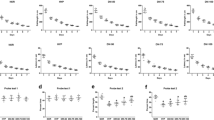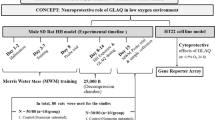Abstract
Exposure to intermittent hypoxia (IH) is associated with cognitive impairments and oxidative stress in brain regions involved in learning and memory. In earlier studies, erythropoietin (EPO) showed a neuroprotective effect in large doses. The aim of the present study was to explore the effect of smaller doses of EPO, such as those used in the treatment of anemia, on IH-induced cognitive deficits and hippocampal oxidative stress in young rats. The effect of concurrent EPO treatment (500 and 1,000 IU/kg/day ip) on spatial learning and memory deficits induced by long-term exposure to IH for 6 weeks was tested using the Morris water maze (MWM) test and the elevated plus maze (EPM) test. Moreover, the effect on hippocampal glutamate and oxidative stress were assessed. Exposure to IH induced a significant impairment of spatial learning and cognition of animals in both MWM and EPM performance parameters. Moreover, hippocampal glutamate and thiobarbituric acid reactive substances (TBARS) increased while antioxidant defenses (GSH and GSH-Px) decreased. EPO in the tested doses significantly reduced the IH-induced spatial learning deficits in both MWM and EPM tests and dose-dependently antagonized the effects of IH on hippocampal glutamate, TBARS, GSH levels, and GSH-Px activity. Treatment with EPO in moderate doses that used for anemia, concurrently with IH exposure can antagonize IH-induced spatial learning deficits and protect hippocampal neurons from IH-induced lipid peroxidation and oxidative stress-induced damage in young rats, possibly through multiple mechanisms involving a potential antioxidative effect.




Similar content being viewed by others
Abbreviations
- BBB:
-
Blood–brain barrier
- CNS:
-
Central nervous system
- DTNB:
-
Ellman’s reagent [5,5′-dithiobis (2-nitrobenzoic acid)]
- EPM:
-
Elevated plus maze test
- EPO:
-
Erythropoietin
- GSH:
-
Intracellular reduced glutathione
- GSH-Px:
-
Glutathione peroxidase
- IH:
-
Intermittent hypoxia
- MWM:
-
Morris water maze test
- RA:
-
Room air
- SDB:
-
Sleep-disordered breathing
- TBARS:
-
Thiobarbituric acid reactive substance
References
Chang S, Chae K (2010) Obstructive sleep apnea syndrome in children: epidemiology, pathophysiology, diagnosis and sequelae. Korean J Pediatr 53:863–871
Arnaud C, Dematteis M, Pepin J, Baguet J, Lévy P (2009) Obstructive sleep apnea, immuno-inflammation, and atherosclerosis. Semin Immuno Pathol 31:113–125
Li RC, Row BW, Gozal E, Kheirandish L, Fan Q, Brittian KR et al (2003) Cyclooxygenase 2 and intermittent hypoxia-induced spatial deficits in the rat. Am J Respir Crit Care Med 168:469–475
Shan X, Chi L, Ke Y, Luo C, Qian SY, Gozal D et al (2007) Manganese superoxide dismutase protects mouse cortical neurons from chronic intermittent hypoxia mediated oxidative damage. Neurobiol Dis 28(2):206–215
Miskowiak KW, Vinberg M, Harmer CJ, Ehrenreich H, Knudsen GM, Macoveanu J et al (2010) Effects of erythropoietin on depressive symptoms and neurocognitive deficits in depression and bipolar disorder. Trials 11:97
Köllensperger M, Krismer F, Pallua A, Stefanova N, Poewe W, Wenning GK (2011) Erythropoietin is neuroprotective in a transgenic mouse model of multiple system atrophy. Mov Disord 26(3):507–515
Wang L, Zhang Z, Wang Y, Zhang R, Chopp M (2004) Treatment of stroke with erythropoietin enhances neurogenesis and angiogenesis and improves neurological function in rats. Stroke 35:1732–1737
Leist M, Ghezzi P, Grasso G, Bianchi R, Villa P, Fratelli M et al (2004) Derivatives of erythropoietin that are tissue protective but not erythopoietic. Science 305:239–242
Brines ML, Ghezzi P, Keenan S, Agnello D, de Lanerolle NC, Cerami C et al (2000) Erythropoietin crosses the blood–brain barrier to protect against experimental brain injury. Proc Natl Acad Sci USA 97:10526–10531
Banks WA, Jumbe NL, Farrell CL, Niehoff ML, Heatherington AC (2004) Passage of erythropoietic agents across the blood–brain barrier: a comparison of human and murine erythropoietin and the analog darbepoetin alfa. Eur J Pharmacol 505:93–101
Okazaki T, Ebihara S, Asada M, Yamanda S, Niu K, Arai H (2008) Erythropoietin promotes the growth of tumors lacking its receptor and decreases survival of tumor-bearing mice by enhancing angiogenesis. Neoplasia 10:932–939
Gombos Z, Danihel L, Repiska V, Acs G, Furth E (2011) Expression of erythropoietin and its receptor increases in colonic neoplastic progression: the role of hypoxia in tumorigenesis. Indian J Pathol Microbiol 54:273–278
Gozal E, Row BW, Schurr A, Gozal D (2001) Developmental differences in cortical and hippocampal vulnerability to intermittent hypoxia in the rat. Neurosci Lett 305:197–201
Morris R (1984) Developments of a water-maze procedure for studying spatial learning in the rat. J Neurosci Meth 11:47–60
Sharma V, Nehru B, Munshi A, Jyothy A (2010) Antioxidant potential of curcumin against oxidative insult induced by pentylenetetrazol in epileptic rats. Methods Find Exp Clin Pharmacol 32:227–232
Ohkawa H, Ohishi N, Yagi K (1979) Assay for lipid peroxides in animal tissues by thiobarbituric acid reaction. Anal Biochem 95:351–358
Griffith OW (1980) Determination of glutathione and glutathione disulfide using glutathione reductase and 2-vinylpyridine. Anal Biochem 106:207–212
Lund P (1986) L-glutamine and L-glutamate: UV-method with glutaminase and glutamate dehydrogenase. In: Bergmeyer HU (ed) Methods enzyme analys. VCH verlagesllschaft, Weinheim, pp 357–363
Paglia DE, Valentine WN (1967) Studies on the quantitative and qualitative characterization of erythrocyte glutathione peroxidase. J Lab Clin Med 70:158–169
Lowry O, Rosenbrough N, Farr A, Randall R (1951) Protein measurement with the Folinphenol reagent. J Biol Chem 193:265–275
Cai XH, Zhou YH, Zhang CX, Hu LG, Fan XF, Li CC et al (2010) Chronic intermittent hypoxia exposure induces memory impairment in growing rats. Acta Neurobiol Exp 70:279–287
Row B, Liu R, Xu W, Kheirandish L, Gozal D (2003) Intermittent hypoxia is associated with oxidative stress and spatial learning deficits in the rat. Am J Respir Crit Care Med 167:1548–1553
Kumar R, Singh J, Singh N (2010) Effects of Erythropoietin on memory deficits and brain oxidative stress in the mouse models of dementia. Korean J Physiol Pharmacol 14:345–352
van der Kooij MA, Groenendaal F, Kavelaars A, Heijnen CJ, van Bel F (2008) Neuroprotective properties and mechanisms of erythropoietin in in vitro and in vivo experimental models for hypoxia/ischemia. Brain Res Rev 59:22–33
Haiden N, Schwindt J, Cardona F, Berger A, Klebermass K, Wald M et al (2006) Effects of a combined therapy of erythropoietin, iron, folate, and vitamin B12 on the transfusion requirements of extremely low birth weight infants. Pediatrics 118:2004–2013
Kumral A, Tüzün F, Oner MG, Genç S, Duman N, Ozkan H (2011) Erythropoietin in neonatal brain protection: the past, the present and the future. Brain Dev 33:632–643
Parle M, Singh N (2004) Animal models of testing memory. Asia Pac J Pharmacol 16:101–120
Sharma AC, Kulkarni SK (1992) Evaluation of learning and memory mechanisms employing elevated plus-maze in rats and mice. Prog Neuropsychopharmacol Biol Psychiatry 16:117–125
Ishii M, Iwamoto T, Nagai A, Sasao G, Iwasaki M, Kuwahira I (2010) Polycythemia and changes in erythropoietin concentration in rats exposed to intermittent hypoxia. Adv Exp Med Biol 662:121–126
Winnicki M, Shamsuzzaman A, Lanfranchi P, Accurso V, Olson E, Davison D, Somers VK (2004) Erythropoietin and obstructive sleep apnea. Am J Hypertens 17(9):783–786
Brugniaux JV, Pialoux V, Foster GE, Duggan CT, Eliasziw M, Hanly PJ et al (2011) Effects of intermittent hypoxia on erythropoietin, soluble erythropoietin receptor and ventilation in humans. Eur Respir J 37(4):880–887
Dayyat EA, Zhang SX, Wang Y, Cheng ZJ, Gozal D (2012) Exogenous erythropoietin administration attenuates intermittent hypoxia-induced cognitive deficits in a murine model of sleep apnea. BMC Neurosci 13:77
Jelkmann W (2005) Effects of erythropoietin on brain function. Curr Pharm Biotechnol 6:65–79
Parfenova H, Basuroy S, Bhattacharya S, Tcheranova D, Qu Y, Regan RF, Leffler CW (2006) Glutamate induces oxidative stress and apoptosis in cerebral vascular endothelial cells: contributions of HO-1and HO-2 to cytoprotection. Am J Physiol Cell Physiol 290:C1399–C1410
Xu X, Dai H, Shi Y (2009) Erythropoietin protects primary cultures of rat cortical neurons from hypoxia-induced toxicity through attenuating both glutamate release and NMDA receptor evoked neurotoxicity pathway. Pharmazie 64:210–232
Hung MW, Tipoe GL, Poon AM, Reiter RJ, Fung ML (2008) Protective effect of melatonin against hippocampal injury of rats with intermittent hypoxia. J Pineal Res 44:214–221
Abdel-Wahab BA, Abd El-Aziz SM (2012) Ginkgo biloba protects against intermittent hypoxia-induced memory deficits and hippocampal DNA damage in rats. Phytomedicine 19:444–450
Lavie L, Vishnevsky A, Lavie P (2004) Evidence for lipid peroxidation in obstructive sleep apnea. Sleep 27:123–128
Solaroglu I, Solaroglu A, Kaptanoglu E, Dede S, Haberal A, Beskonakli E et al (2003) Erythropoietin prevents ischemia-reperfusion from inducing oxidative damage in fetal rat brain. Childs Nerv Syst 19:19–22
Toba H, Nakashima K, Oshima Y, Kojima Y, Tojo C, Nakano A et al (2010) Erythropoietin prevents vascular inflammation and oxidative stress in subtotal nephrectomized rat aorta beyond haematopoiesis. Clin Exp Pharmacol Physiol 37:1139–1146
Veasey SC, Davis C, Zhan G, Hsu YJ, Fenik P, Pratico D, Gow AJ (2004) Long-term intermittent hypoxia in mice: protracted hypersomnolence with oxidative injury to sleep-wake brain regions. Sleep 27:194–201
Zhan G, Fenik P, Pratico D, Veasey SC (2005) Inducible nitric oxide synthase in long-term intermittent hypoxia: hypersomnolence and brain injury. Am J Respir Crit Care Med 171(12):1414–1420
Genc K, Genc S, Baskin H, Semin I (2006) Erythropoietin decreases cytotoxicity and nitric oxide formation induced by inflammatory stimuli in rat oligodendrocytes. Physiol Res 55(1):33–38
Calapai G, Marciano MC, Corica F, Allegra A, Parisi A, Frisina N et al (2000) Erythropoietin protects against brain ischemic injury by inhibition of nitric oxide formation. Eur J Pharmacol 401(3):349–356
Pialoux V, Hanly PJ, Foster GE, Brugniaux JV, Beaudin AE, Hartmann SE et al (2009) Effects of exposure to intermittent hypoxia on oxidative stress and acute hypoxic ventilatory response in humans. Am J Respir Crit Care Med 180:1002–1009
Sims B, Clarke M, Njah W, Hopkins ES, Sontheimer H (2010) Erythropoietin-induced neuroprotection requires cystine glutamate exchanger activity. Brain Res 1321:88–95
Kumral A, Gonenc S, Acikgoz O, Sonmez A, Genc K, Yilmaz O et al (2005) Erythropoietin increases glutathione peroxidase enzyme activity and decreases lipid peroxidation levels in hypoxic ischemic brain injury in neonatal rats. Biol Neonate 87:15–18
Zinchuk VV, Shul’ga EV, Guliaĭ IE (2010) Erythropoietin influence on oxygen transport function of blood and prooxidant/antioxidant balance in rabbits under lipopolysaccharide injection. Ross Fiziol Zh Im IM Sechenova 96(1):43–49
Kawachi K, Iso Y, Sato T, Wakabayashi K, Kobayashi Y, Takeyama Y, Suzuki H (2012) Effects of erythropoietin on angiogenesis after myocardial infarction in porcine. Heart Vessels 27:79–88
Ning R, Xiong Y, Mahmood A, Zhang Y, Meng Y, Qu C, Chopp M (2011) Erythropoietin promotes neurovascular remodeling and long-term functional recovery in rats following traumatic brain injury. Brain Res 1384:140–150
Gozal D, Kheirandish-Gozal L, Bhattacharjee R, Spruyt S (2010) Neurocognitive and endothelial dysfunction are frequently concordant in children with OSA. Pediatrics 126:e1161–e1167
Hogan AM, Hill CM, Harrison D, Kirkham FJ (2008) Cerebral blood flow velocity and cognition in children before and after adenotonsillectomy. Pediatrics 122:75–82 (Erratum in. Pediatrics 122:689–690)
Yamamoto M, Koshimura K, Kawaquchi M, Sohmiya M, Murakami Y, Kato Y (2000) Stimulating effect of Erythropoietin on the release of dopamine and acetylcholine from the rat brain slice. Neurosci Lett 292:131–133
Viviani B, Bartesaghi S, Corsini E, Villa P, Ghezzi P, Garau A et al (2005) Erythropoietin protects primary hippocampal neurons by increasing the expression of brain-derived neurotrophic factor. J Neurochem 93:412–421
Tabira T, Konishi Y, Gallyas F (1995) Neurotrophic effect of hematopoietic cytokines on cholinergic and other neurons in vitro. Int J Dev Neurosci 13:241–252
Acknowledgments
This work was financially supported by Najran University Program for Health and Medical Research Grants, Grant No. (NU 8/13). The work of this study was carried out in College of Medicine, Najran University, Najran, Saudi Arabia.
Conflict of interest
On behalf of the authors, no conflict of interest is found in this work.
Author information
Authors and Affiliations
Corresponding author
Rights and permissions
About this article
Cite this article
Al-Qahtani, J.M., Abdel-Wahab, B.A. & Abd El-Aziz, S.M. Long-Term Moderate Dose Exogenous Erythropoietin Treatment Protects from Intermittent Hypoxia-Induced Spatial Learning Deficits and Hippocampal Oxidative Stress in Young Rats. Neurochem Res 39, 161–171 (2014). https://doi.org/10.1007/s11064-013-1201-2
Received:
Revised:
Accepted:
Published:
Issue Date:
DOI: https://doi.org/10.1007/s11064-013-1201-2




